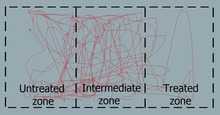Cymbopogon citratus
| Lemon grass | |
|---|---|
 | |
| Scientific classification | |
| Kingdom: | Plantae |
| (unranked): | Angiosperms |
| (unranked): | Monocots |
| (unranked): | Commelinids |
| Order: | Poales |
| Family: | Poaceae |
| Genus: | Cymbopogon |
| Species: | C. citratus |
| Binomial name | |
| Cymbopogon citratus (DC.) Stapf,[1] 1906 | |
| Synonyms[2] | |
|
List
| |
Cymbopogon citratus, commonly known as lemon grass or oil grass, is a tropical plant from Southeast Asia.
Culinary uses
Cymbopogon citratus is abundant in the Philippines and Indonesia where it is known as tanglad or sereh. Its fragrant leaves are traditionally used in cooking, particularly for lechon and roasted chicken.[3]
Medicinal uses
Cymbopogon citratus is often sold in stem form. While it can be grown in warmer temperate regions (such as the UK), it is not hardy to frost.
In the folk medicine of Brazil, it is believed to have anxiolytic, hypnotic, and anticonvulsant properties,[4][5] but at least one study has found no effect on humans.[6] In traditional medicine of India the leaves of the plant are used as stimulant, sudorific, antiperiodic, and anticatarrhal, while the essential oil is used as carminative, depressant, analgesic, antipyretic, antibacterial, and antifungal agent.[7]
Laboratory studies have shown cytoprotective, antioxidant, and anti-inflammatory properties in vitro,[8][9][10] as well as antifungal properties[11] (though Cymbopogon martinii was found to be more effective in that study).
Citronellol, which is thought to possess antihypertensive properties, is an essential oil constituent from Cymbopogon citratus, Cymbopogon winterianus, and Lippia alba. Citronellol has been shown to lower blood pressure in rats by a direct effect on the vascular smooth muscle leading to vasodilation.[12] In a small, randomised, controlled trial, an infusion made from C. citratus was used as an inexpensive remedy for the treatment of oral thrush in HIV/AIDS patients.[13]
Lemon grass contains 65-85% citral and active ingredients such as myrcene, an antibacterial and pain reliever; citronella; citronellol; and geranilol.[14] Hydrosteam distillation, condensation, and cooling were used to separate the oil from the water. Hydrosol or Hydrolat, as a by-product of the distillation process, is a pure natural water or plant water essence used for the production of skin care products such as lotions, creams, and facial cleansing toner in its pure form. The main products are organic unadulterated lemon grass oil (for industrial users), and “negros oil” (mixture of lemon grass oil with virgin coconut oil) used in aromatherapy.[15]
Other uses

Beekeepers sometimes use lemon grass oil in swarm traps to attract swarms.
Lemon grass oil has been tested for its repellency against stable flies,[16] which bite domestic animals.
References
- ↑ "Cymbopogon citratus information from NPGS/GRIN". www.ars-grin.gov. Retrieved 2008-03-02.
- ↑ "The Plant List: A Working List of All Plant Species". Retrieved May 8, 2014.
- ↑ "Tanglad / Lemongrass". Market Manila. August 21, 2006. Retrieved July 27, 2011.
- ↑ Blanco MM, Costa CA, Freire AO, Santos JG, Costa M (March 2009). "Neurobehavioral effect of essential oil of Cymbopogon citratus in mice". Phytomedicine 16 (2-3): 265–70. doi:10.1016/j.phymed.2007.04.007. PMID 17561386.
- ↑ Rodrigues, Eliana & Carlini, E.A. (2006): Plants with possible psychoactive effects used by the Krahô Indians, Brazil. Revista Brasileira de Psiquiatria 28(4): 277-282. PDF fulltext
- ↑ Leite JR, Seabra Mde L, Maluf E et al. (July 1986). "Pharmacology of lemongrass (Cymbopogon citratus Stapf). III. Assessment of eventual toxic, hypnotic and anxiolytic effects on humans". J Ethnopharmacol 17 (1): 75–83. doi:10.1016/0378-8741(86)90074-7. PMID 2429120.
- ↑ Wang L, Waltenberger B, Pferschy-Wenzig EM, Blunder M, Liu X, Malainer C, Blazevic T, Schwaiger S, Rollinger JM, Heiss EH, Schuster D, Kopp B, Bauer R, Stuppner H, Dirsch VM, Atanasov AG. Natural product agonists of peroxisome proliferator-activated receptor gamma (PPARγ): a review. Biochem Pharmacol. 2014 Jul 29. pii: S0006-2952(14)00424-9. doi: 10.1016/j.bcp.2014.07.018. PubMed PMID 25083916.
- ↑ Anti-inflammatory activity of Cymbopogon citratus leaf infusion in lipopolysaccharide-stimulated dendritic cells: contribution of the polyphenols. Figueirinha A. Cruz MT. Francisco V. Lopes MC. Batista MT. Journal of Medicinal Food. 13(3):681-90, 2010 Jun
- ↑ Inhibitory effect of citral on NO production by suppression of iNOS expression and NF-kappa B activation in RAW264.7 cells. Lee HJ. Jeong HS. Kim DJ. Noh YH. Yuk DY. Hong JT. Archives of Pharmacal Research. 31(3):342-9, 2008 Mar.s.
- ↑ Suppression of oxidative stress and pro-inflammatory mediators by Cymbopogon citratus D. Stapf extract in lipopolysaccharide stimulated murine alveolar macrophages. Food Chem Toxicol. 2010 Oct;48(10):2913-9 Authors: Tiwari M, Dwivedi UN, Kakkar P
- ↑ Sunita Bansod; Mahendra Rai (2008). "Antifungal Activity of Essential Oils from Indian Medicinal Plants Against Human Pathogenic Aspergillus fumigatus and A. niger". World Journal of Medical Sciences. pp. 81–88. Retrieved November 4, 2012.
- ↑ Hypotensive and vasorelaxant effects of citronellol, a monoterpene alcohol, in rats. Bastos JF. Moreira IJ. Ribeiro TP. Medeiros IA. Antoniolli AR. De Sousa DP. Santos MR. Basic & Clinical Pharmacology & Toxicology. 106(4):331-7, 2010 Apr.
- ↑ Treatment of oral thrush in HIV/AIDS patients with lemon juice and lemon grass (Cymbopogon citratus) and gentian violet. Wright SC. Maree JE. Sibanyoni M. Phytomedicine. 16(2-3):118-24, 2009 Mar.
- ↑ Baby P. Skaria, P.P. Joy, Samuel Mathew, Gracy Mathew, Ancy Joseph, and Ragina Joseph, Aromatic Plants, vol. 1 (New Delhi, India: New India Publishing Agency, 2007), page 103.
- ↑ Inquirer.net, ‘Tanglad’ goes mainstream, yields essential oils
- ↑ 16.0 16.1 Baldacchino, Frédéric; Tramut, Coline; Salem, Ali; Liénard, Emmanuel; Delétré, Emilie; Franc, Michel; Martin, Thibaud; Duvallet, Gérard; Jay-Robert, Pierre (2013). "The repellency of lemongrass oil against stable flies, tested using video tracking". Parasite 20: 21. doi:10.1051/parasite/2013021. ISSN 1776-1042. PMID 23759542.